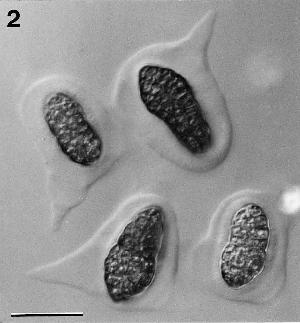
Image credit: Jan Kohlmeyer (1984), reprinted with permission from NAMA (www.namyco.org).
Decorospora gaudefroyi Inderb., Kohlm. et Volkm.-Kohlm.
is a marine ascomycete in the Pleosporaceae. The sequenced strain
was collected in 1962 in Etang du Doul in southern France from
Salicornia fruticosa (Kohlmeyer 1962), and deposited in
the CBS culture collection by Jan Kohlmeyer as strain CBS 332.63.
Decorospora gaudefroyi grows well in culture and readily
decomposes balsa wood and tunicate mantles (Kohlmeyer 1962). These
characteristics may prove useful for practical applications
requiring the degradation of lignin and cellulose found in wood.
Decorospora gaudefroyi is also salt tolerant and fruits on
salt encrusted pilings. Understanding the mechanism of salt
tolerance may assist in the development of salt tolerant crops in
agriculture. Decorospora gaudefroyi is closely related to
the economically important plant pathogens Alternaria,
Cochliobolus, Pyrenophora and
Setosphaeria, and will prove useful to study the origin of
pathogenicity in these fungi.
Decorospora gaudefroyi is easy to identify by its
ascospores that are surrounded by a sheath that is drawn out into
2-3 protrusions at each apex (see image). It has a wide
distribution that includes temperate waters of Europe, North
America and Argentina. It is not host specific and occurs on
driftwood, pilings and a variety of marsh plants.
References:
- Kohlmeyer, J. 1962. Über Pleospora gaudefroyi Patouillard. Willdenowia 3:315-324.
- Kohlmeyer, J. 1984. Are there any marine mushrooms? McIlvainea 6:44-50.
Genome Reference(s)
Haridas S, Albert R, Binder M, Bloem J, LaButti K, Salamov A, Andreopoulos B, Baker SE, Barry K, Bills G, Bluhm BH, Cannon C, Castanera R, Culley DE, Daum C, Ezra D, González JB, Henrissat B, Kuo A, Liang C, Lipzen A, Lutzoni F, Magnuson J, Mondo SJ, Nolan M, Ohm RA, Pangilinan J, Park HJ, Ramírez L, Alfaro M, Sun H, Tritt A, Yoshinaga Y, Zwiers LH, Turgeon BG, Goodwin SB, Spatafora JW, Crous PW, Grigoriev IV
101 Dothideomycetes genomes: A test case for predicting lifestyles and emergence of pathogens.
Stud Mycol. 2020 Jun;96():141-153. doi: 10.1016/j.simyco.2020.01.003
